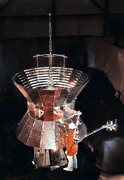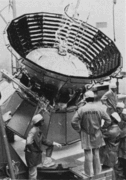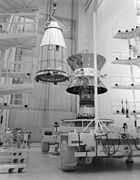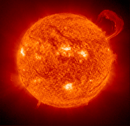Helios (spacecraft)
|
Prototype of the Helios spacecraft | |
| Operator | NASA / FRG |
|---|---|
| Major contractors | MBB |
| Mission type | Orbiters |
| Launch date |
Helios-A : 1974-12-10 07:11:01.5 UTC (40 years, 4 months and 3 days ago) Helios-B : 1976-01-15 05:34:00 UTC (39 years, 2 months and 29 days ago) |
| Launch vehicle | Titan IIIE / Centaur |
| Launch site |
Space Launch Complex 41 Cape Canaveral Air Force Station |
| Mission duration |
Helios-A : January 16, 1975 to February 18, 1985 Helios-B : July 21, 1976 to December 23, 1979 |
| Satellite of | Sun |
| COSPAR ID |
Helios-A : 1974-097A Helios-B : 1976-003A |
| Homepage |
Helios-A : NASA Solarsystem Exploration page Helios-B : NASA Solarsystem Exploration page |
| Mass | 370 kg (820 lb) |
| Power | (solar array) |
Helios-A and Helios-B (also known as Helios 1 and Helios 2), are a pair of probes launched into heliocentric orbit for the purpose of studying solar processes. A joint venture of the Federal Republic of Germany (West Germany) and NASA, the probes were launched from Cape Canaveral, Florida, on Dec. 10, 1974, and Jan. 15, 1976, respectively.
The probes are notable for having set a maximum speed record among spacecraft at 252,792 km/h[1] (157,078 mi/h or 43.63 mi/s or 70.22 km/s or 0.000234c). Helios 2 flew three million kilometers closer to the Sun than Helios 1, achieving perihelion on 17 April 1976 at a record distance of 0.29 AU (or 43.432 million kilometers),[2] slightly inside the orbit of Mercury. Helios 2 was sent into orbit 13 months after the launch of Helios 1. The Helios space probes completed their primary missions by the early 1980s, but they continued to send data up to 1985. The probes are no longer functional but still remain in their elliptical orbit around the Sun.
Mission background
Scientific instruments
| Instrument Name | Description |
|---|---|
| |
Measures the velocity and distribution of the solar wind plasma. |
| --> |
Measures the field strength and direction of low frequency magnetic fields in the Sun’s environment. |
| --> |
Compliments the Flux-Gate Magnetometer by measuring the magnetic fields between 0 and 3 kHz. |
| --> |
Measures and analyzes waves of free ions and electrons in the solar wind plasma, 10 Hz to 3 MHz region. |
| --> |
Measures protons, electrons and x-rays to determine the distribution of cosmic rays. |
| --> |
Investigates the higher energy portion of the crossover region between the solar wind particles and the cosmic rays. |
| --> |
Measures the scattering of sunlight by interplanetary dust particles. |
| --> |
Investigates the composition, charge, mass, velocity and direction of interplanetary dust particles. |
|
Mission profile
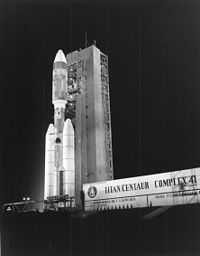
Launch and trajectory
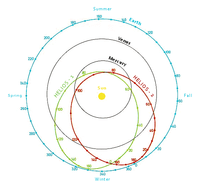 Trajectory of the Helios space probes. |
Timeline of travel
| Date | Event |
|---|---|
| |
Launch of Helios-A |
| |
Launch of Helios-B |
| |
Closest flyby of the Sun of any spacecraft, performed by Helios II. |
See also
References
- ↑ Wilkinson, John (2012), New Eyes on the Sun: A Guide to Satellite Images and Amateur Observation, Astronomers' Universe Series, Springer, p. 37, ISBN 3-642-22838-0
- ↑ Solar System Exploration: Missions: By Target: Our Solar System: Past: Helios 2
External links
| Wikimedia Commons has media related to Helios (spacecraft). |
- Helios 1 - NSSDC Master Catalog
- Helios 2 - NSSDC Master Catalog
- Helios 1 Mission Profile by NASA's Solar System Exploration
- Helios 2 Mission Profile by NASA's Solar System Exploration
- Titan/Centaur D-1T TC-2, Helios A, Flight Data Report
- Titan/Centaur D-1T TC-5 Helios B, Flight Data Report
- Honeysuckle Creek Tracking Station
- Astronautix Helios page
- Helios-Project - Max-Planck-Institut für Sonnensystemforschung
| ||||||||||||||||||||||||
| ||||||||||||||
| ||||||||||
| ||||||||||


